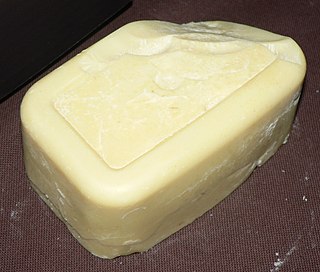
A mango is an edible stone fruit produced by the tropical tree Mangifera indica. It originated from the region between northwestern Myanmar, Bangladesh, and northeastern India. M. indica has been cultivated in South and Southeast Asia since ancient times resulting in two types of modern mango cultivars: the "Indian type" and the "Southeast Asian type". Other species in the genus Mangifera also produce edible fruits that are also called "mangoes", the majority of which are found in the Malesian ecoregion.

Mangifera is a genus of flowering plants in the cashew family, Anacardiaceae. It contains about 69 species, with the best-known being the common mango. The center of diversity of the genus is in the Malesian ecoregion of Southeast Asia, particularly in Sumatra, Borneo, and the Malay peninsula. They are generally canopy trees in lowland rainforests, reaching a height of 30–40 m (98–131 ft).

Cocoa butter, also called theobroma oil, is a pale-yellow, edible fat extracted from the cocoa bean. It is used to make chocolate, as well as some ointments, toiletries, and pharmaceuticals. Cocoa butter has a cocoa flavor and aroma. Its melting point is slightly below human body temperature. It is an essential ingredient of chocolate and related confectionary products. Cocoa butter does not contain butter or other animal products; it is vegan.

Alkylresorcinols (ARs), also known as resorcinolic lipids, are amphiphilic phenolic lipids characterised by a non-polar odd-numbered alkyl side chain with up to 27 carbon atoms attached to a polar resorcinol (1,3-dihydroxybenzene) ring.

Xanthone is an organic compound with the molecular formula O[C6H4]2CO. It is a white solid.
Camphene is a bicyclic organic compound. It is one of the most pervasive monoterpenes. As with other terpenes, it is insoluble in water, flammable, colorless, and has a pungent smell. It is a minor constituent of many essential oils such as turpentine, cypress oil, camphor oil, citronella oil, neroli, ginger oil, valerian, and mango. It is produced industrially by isomerization of the more common alpha-pinene using a solid acid catalyst such as titanium dioxide.
Neoflavonoids are a class of polyphenolic compounds. While flavonoids have the 2-phenylchromen-4-one backbone, neoflavonoids have the 4-phenylchromen backbone with no hydroxyl group substitution at position 2.

Mangifera odorata, commonly known as kwini, huani, or Saipan mango, is a species of plant with edible fruit in the family Anacardiaceae. It is similar to the related mango but is characterized by a strong turpentine-like smell on the skin and fibrous flesh. It is native to tropical Southeast Asia, but its exact original native range is unknown because it is only known from cultivated specimens and is believed to be a hybrid of Mangifera indica and Mangifera foetida. It is grown throughout Southeast Asia, from peninsular Thailand, to Malaysia, Indonesia and the southern Philippines. It has also been occasionally cultivated in southern Vietnam and the Marianas Islands.

Mangifera pajang, commonly known as wild mango, is a species of tree in the family Anacardiaceae. It is endemic to Borneo, where it is known by the various native names: buahbambangan, buah mawang and buah embang.

Mangifera indica, commonly known as mango, is a species of flowering plant in the family Anacardiaceae. It is a large fruit tree, capable of growing to a height of 30 metres. There are two distinct genetic populations in modern mangoes – the "Indian type" and the "Southeast Asian type".

Isoquercetin, isoquercitrin or isotrifoliin is a flavonoid, a type of chemical compound. It is the 3-O-glucoside of quercetin. Isoquercitrin can be isolated from various plant species including Mangifera indica (mango) and Rheum nobile. It is also present in the leaves of Annona squamosa, Camellia sinensis (tea). and Vestia foetida

Tectorigenin is an O-methylated isoflavone, a type of flavonoid. It ha been isolated from leopard lily, Algerian iris and East Asian arrowroot.

Asplenium montanum, commonly known as the mountain spleenwort, is a small fern endemic to the eastern United States. It is found primarily in the Appalachian Mountains from Vermont to Alabama, with a few isolated populations in the Ozarks and in the Ohio Valley. It grows in small crevices in sandstone cliffs with highly acid soil, where it is usually the only vascular plant occupying that ecological niche. It can be recognized by its tufts of dark blue-green, highly divided leaves. The species was first described in 1810 by the botanist Carl Ludwig Willdenow. No subspecies have been described, although a discolored and highly dissected form was reported from the Shawangunk Mountains in 1974. Asplenium montanum is a diploid member of the "Appalachian Asplenium complex," a group of spleenwort species and hybrids which have formed by reticulate evolution. Members of the complex descended from A. montanum are among the few other vascular plants that can tolerate its typical habitat.

Asplenium bradleyi, commonly known as Bradley's spleenwort or cliff spleenwort, is a rare epipetric fern of east-central North America. Named after Professor Frank Howe Bradley, who first collected it in Tennessee, it may be found infrequently throughout much of the Appalachian Mountains, the Ozarks, and the Ouachita Mountains, growing in small crevices on exposed sandstone cliffs. The species originated as a hybrid between mountain spleenwort and ebony spleenwort ; A. bradleyi originated when that sterile diploid hybrid underwent chromosome doubling to become a fertile tetraploid, a phenomenon known as allopolyploidy. Studies indicate that the present population of Bradley's spleenwort arose from several independent doublings of sterile diploid hybrids. A. bradleyi can also form sterile hybrids with several other spleenworts.

Kaempferol 7-O-glucoside is a flavonol glucoside. It can be found in Smilax china, and in the fern Asplenium rhizophyllum, and its hybrid descendants, as part of a complex with caffeic acid.

The pomegranate ellagitannins, which include punicalagin isomers, are ellagitannins found in the sarcotestas, rind (peel), bark or heartwood of the pomegranate fruit.

Iris unguicularis, the Algerian iris, is a rhizomatous flowering plant in the genus Iris, native to Greece, Turkey, Western Syria, and Tunisia. It grows to 30 centimetres (12 in), with grassy evergreen leaves, producing pale lilac or purple flowers with a central band of yellow on the falls. The flowers appear in winter and early spring. They are fragrant, with pronounced perianth tubes up to 20 cm (7.9 in) long.

Fusarium mangiferae is a fungal plant pathogen that infects mango trees. Its aerial mycelium is white and floccose. Conidiophores on aerial mycelium originating erect and prostrate from substrate; they are sympodially branched bearing mono and polyphialides. Polyphialides have 2–5 conidiogenous openings. Phialides on the aerial conidiophores mono- and polyphialidic. Sterile hyphae are absent. Microconidia are variable in shape, obovoid conidia are the most abundant type, oval to allantoid conidia occurring occasionally. Microconidia mostly 0-septate with 1-septate conidia occurring less abundantly. Sporodochia are present. Macroconidia are long and slender, usually 3–5 septate. Chlamydospores are absent.
Deporaus marginatus, commonly known as the mango leaf-cutting weevil, is a species of leaf weevil in the beetle family Attelabidae. It is a light tan colour with black elytra, and is found in tropical Asia where it is a pest of mango.

Samadera indica, the bitter wood or Niepa bark tree, is a species of plant in the family Simaroubaceae. It is a shrub or tree and grows primarily in wet tropical regions, from west Africa, through India, then down through Indonesia to Malesia.


















